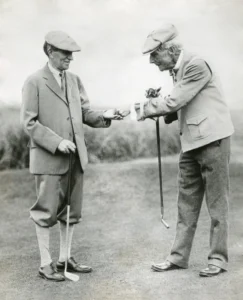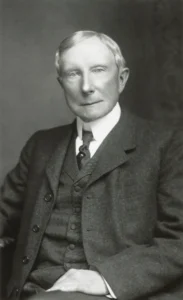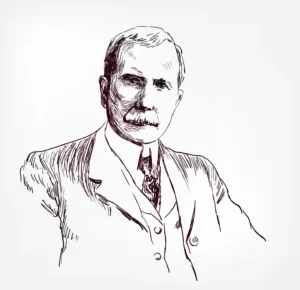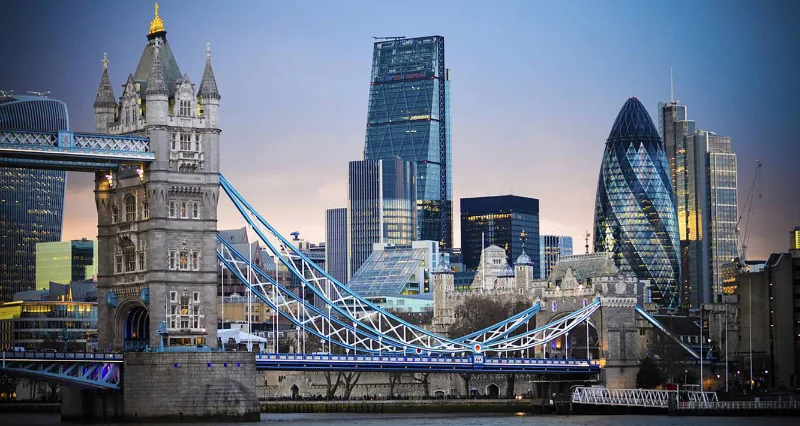Even John D. Rockefeller’s father was a crook. And even though he didn’t care much for his family, he did pass something on to his son. “I’m not gonna waste any opportunity to cheat my boys. I’m gonna deal with these boys, and I’m gonna take them over whenever I can. I want them to be shrewd,” William Rockefeller once boasted to a friend, at least according to family chronicler Allan Nevins.
One day they were playing together and the son, as usual, jumped from his chair into his arms at his father’s prompting. But this time, Daddy pulled back his outstretched arms and little John did a little dance. “Big Bill” bent over him and said, “Remember, you must never trust anyone, not even your best friend. You must trust only yourself.” He must have known better himself. He was an ointment peddler and charlatan who called himself the Doctor and peddled oil in a bottle as a cure for warts, cancer, impotence, or anything else you can think of.
With a bit of exaggeration, you could say he was the first oilman in a family that dominated the US oil industry in just ten years. Thus, the Rockefellers became the most powerful clan ever to live in America, yet little is known about them. Or is that why?
Family of philanthropists or criminals?
There are two different views of this family. One is that they are hard-nosed businessmen who lost their greatest power with the breakup of their oil monopoly a century ago and then became common billionaires and philanthropists. The other sees them as robber barons who have not lost their monopoly but are still gaining power, and have fortunes in the trillions (that’s not a typo) of dollars.
If even a fraction of the information about all the projects they stand behind were true, it would make John Davison Rockefeller and his vast progeny look like a cross between Darth Vader, Dracula, and an epidemic. But where is the truth? ZEN has embarked on an exciting journey in the footsteps of the embodiment of the American Dream to bring you some publicly traceable information.
Unlike his father, John D., the most scholarly of the eight children, had the ambition to spare, and before he was twenty, he was in the farming business. In 1859, his associates sent him to the Pennsylvania town of Titusville to see if the oil discovered there could be as lucrative as rumored. Rockefeller soon realized that processing and transporting it were the real golden vein. And so he founded the Standard Oil Company in 1870.
The thing John D. hated most of all was competition. If there were 27 refineries in the Cleveland area at the time of Standard Oil’s founding, within a few years John had a real masterpiece. Not only did he cut a deal with America’s richest man, Cornelius Vanderbilt, and then his rival Tom Scott, to create a railroad monopoly on the shipment of crude oil, giving him a decisive advantage over others – he also coerced and bribed the two tycoons into giving him illegal commissions or rebates not only on his shipments but on every barrel shipped by his competitors.
Vanderbilt, nicknamed the Commodore, was to declare, according to an 1881 article in The Atlantic magazine, The Story of the Great Monopoly, that there was only one man who could dictate to him – Rockefeller. Thus, in a single year, he ingeniously managed to put the other oil refiners out of business, using their own money. Simon Sterne, a lawyer for the New York Railroad Commission, which tried to investigate the unfair practices on the rails, said that “the relationship between the railroad companies and Standard Oil has proven to be the most brazen perversion of the public transportation obligation for private purposes in the history of the world.”
To build such an empire, however, even the most astute businessman needs one thing – money. That, according to journalist Jim Marrs (he became a New York Times best-selling nonfiction author), was provided to Rockefeller by the National City Bank of Cleveland, identified by congressional hearings in the 1870s as one of three American banks controlled by the equally (all)able European Rothschild dynasty (see box at end of article).
John D. Omnipotent
For $72,500, Rockefeller bailed out and forced his partners out of the firm against their will. And then he systematically deceived his rivals. Initially, he offered them money or Standard Oil stock in exchange for selling the companies to him at the lowest prices he could offer. The smarter ones took the stock. But how did the stubborn ones fare?
“If Standard Oil failed to expand by peaceful means, it was prepared to resort to violence. … He approached the head of the enemy refinery. The foreman was given a life annuity, and in due course, a small explosion occurred in that independent refinery,” wrote journalist Matthew Josephson in his 1934 book The Robber Barons. With such ingenuity, it’s no wonder that by 1880 JDR owned more than 90% of America’s oil production.
Rockefeller was a specialist in dealing with front men in politics, the media, and his competitors – the tactic of finding people who could be bought worked best for him. “The ability to deal with people is just as monetizable as sugar or coffee,” he used to say. All good oligarchs still follow this sophisticated system to this day. William Manchester wrote in his book Rockefeller Family Portrait: “For a long time, the public was unaware of his power because he pretended to compete with companies he secretly owned outright. His real rivals were discovering that he had their most loyal officials in his pocket. The tentacles of the octopus were everywhere.”
By the time the public began to take notice, it was too late. Thanks to five years of investigative research by the famous Ida Tarbell, the daughter of one of the small Pennsylvania oil producers among whom John D. had the nickname Reckafellow or All-Powerful, Americans learned how organized crime operated under the guise of piety, honesty, and the free market. The reports caused an uproar, and there was talk of breaking up the monopoly. On May 15, 1911, the U.S. Supreme Court ruled, “Seven persons and their corporate instrumentality conspired against their fellow citizens. In the interest of national security, this conspiracy must be neutralized…” And so Standard Oil was broken up.
But Rockefeller was prepared for this. As the renowned economist Ferdinand Lundberg mentioned in his book The Rich and the Superrich: “The account of the history of all the authors, those who favor him and others, makes it clear that Rockefeller was deeply conspiratorial, scheming, always planning years, with a clear vision…” And so the passage of the antitrust law helped him.
He first transformed the Standard Oil Company into the Standard Company Trust – the first large corporation as we know it today. The structure involved a maze of business relationships and entanglements that made it almost impossible to untangle. The break-up of Standard Oil created the 34 companies known today as ExxonMobil, BP, and Chevron – corporations that still dominate the Western oil trade today. The successor companies were always linked through banks by at least one member of the supervisory board.
Smart Foundations
At that time, however, his reputation as a skillful self-taught man was fading and criticism was directed at him from all sides. So John D. hired a man named Ivy Lee – then a leader in PR and advertising. He gave him a simple piece of advice: he could improve his reputation by giving away money. Rockefeller’s transformation into a philanthropist is well described in the book The Rockefeller Files by journalist Gary Allen.
It can be summarized simply as follows: he gave money to his newly created foundations, and then let the foundations spend their money to bring even more power and profit to his empire.
“The principle is that you give up ownership but keep control. Most people don’t think they own something unless they have ownership. The Rockefellers know that’s a big mistake. Often it’s better if a trust or foundation under your control owns your property.”
Plus, if no one knows about you, you get to keep the most precious thing – freedom…
Family Life Experience
Oil
John D. Rockefeller built the world’s largest oil company, Standard Oil. In 1877, Standard Oil controlled 95% of the US oil market. In 1882, John D. had to promise to sell off parts of his empire because of antitrust laws. But he set up new companies and sold them de facto to himself, making himself even stronger. Today, after various mergers, we know them as ExxonMobil (Esso in Europe), BP (Aral), Unilever, Chevron, and Texaco. And so the first billionaire was born.
Banks
John D. made good use of his oil profits and banking became the Rockefellers’ domain. The Rockefellers rose among the eight major banking families (Chase Manhattan Bank, Citigroup). Senator Nelson Aldrich was to investigate whether the big banks had caused the stock market panic of 1907. Instead, he brought their representatives to a secret meeting where they wrote the Banking Act. Thus, since 1913, a banking cartel euphemistically called the Federal Reserve has been issuing money and lending it to governments and businesses. Aldrich’s daughter married John D. Jr.
The Great Depression
Sixteen years after the Fed was officially created to prevent further crises, the big banks that make it up inflated a bubble and then pulled money out of the stock market. Small banks and businesses failed, whereupon the bankers, led by the Morgans, Rockefellers, and Rothschilds, bought them up cheaply and consolidated their power. Since then, the scenario has repeated itself several times. 1% of Americans own over 90% of all assets. Those who have a monopoly on spending also control the corporations, since they depend on cheap financing…
Food
We can also thank the Rockefellers and their foundation in partnership with big agribusiness for the shift from traditional tillage to synthetic fertilizers made from nothing but petroleum. The revolution, cynically called ‘green’, has caused rural depopulation, the destruction of small farmers, pesticide infestation, soil depletion, and food contamination, despite the short-term increase in yields. However, global agribusiness has given the oil companies new markets. Moreover, the dynasties are believed to own significant stakes in agribusinesses.
Health
The Rockefeller Foundation has also revolutionized medicine. It has funded universities, hospitals, and research institutes that have promoted drug research. Non-chemical procedures were not subsidized. In 1939, Standard Oil, together with its cartel partner, the German corporation I. G. Farben (now Bayer or BASF), with which it traded briskly during the war and which, among other things, produced Zyklon B, founded the so-called Drug Trust. The family influences a significant part of the pharmaceutical industry and pays the American Medical Association.
Education
The Rockefellers were behind the founding of Harvard University and Princeton, Stanford, and Yale universities. In Europe, for example, they have “sponsored” the most influential economic university that determines what others should think about economics – the London School of Economics. They also created the US National Education Association, which influences, for example, what textbooks are used in schools.
At a time when Standard Oil was facing antitrust law and the US states were one by one passing the 16th Amendment to the Constitution on progressive income tax, the richest American could create several tax-exempt foundations and distribute shares among them. “It had the same effect as moving your wallet from your right pocket to your left. He managed not only to avoid income taxes but also those on estate or inheritance taxes. Generations of the family have given away millions of dollars to themselves. That’s why they use so many trusts. There may be tens of thousands of them,” Allen wrote in 1976. As a result, the press began to write about JDR as a good-for-nothing. And the Rockefellers’ reputation as philanthropists has stuck to this day.
Avoiding taxes helped the main monopolist to finish off the competition and become even richer when it should have been the other way around. The tax-free piggy bank was carefully described by the Washington Post:
“For two generations, the vast fortune John D. left behind has been fragmented into various layers of trusts and closely held corporations that are not required to disclose information, do not volunteer it, and politely decline requests for it.”
Financing Lenin or Hitler? No problem!
When Democrat Eugene Cox’s congressional committee tried to expose the fraud and “subversive elements” behind the foundations in 1952, “less dedicated colleagues” were planted on his team by his party. Cox died during the investigation, and his colleague Carroll Reece, who wanted to continue the investigation, became the target of slander by the foundations and congressmen as well as the corporate press. At least he was able to prove under pressure that the closely linked Rockefeller, Carnegie, and Ford foundations had been sponsoring Communist propaganda from the beginning with taxpayer money. Yes, you read that right. According to Reece, the foundations tried to manipulate Americans into being in favor of a global world government. Especially by supporting wars, because wars have been known to scare citizens into agreeing to anything…
As later developments have shown, it was the political agenda of the elites who influence corporations, and thus politics, that was behind the creation of the process we know today as globalization. And in this game, ideological enemies are not such adversaries. According to available documents, the Rockefellers, for example, financed not only Lenin but always both sides in any conflict, from the world wars to the one in Vietnam. The interested reader can find details, for example, in the book by the American professor Antony Sutton, Wall Street, and The Bolshevik Revolution. And it was only thanks to Standard Oil – which was a partner company of I.G. Farben during the Second World War, which also produced the infamous Zyklon B – and its aviation gasoline additive, tetramethylene, that German bombers were able to take off…
In 1973, when oil deposits were found in the East China Sea, David Rockefeller (John D’s grandson), who is still the head of the family today, went to China to do business, where Mao Zedong was in office. During his trip, he wrote a remarkable article in the New York Times on August 10, entitled From a Chinese Traveler: “You are immediately struck by the spirit of national harmony here… Whatever the cost of the Chinese Revolution, it has succeeded in creating a more efficient and loyal government, and also in cultivating strong morale. The social experiment in China under Chairman Mao is one of the most important and successful in human history.” It was the experiment that killed tens of millions of people…
World of debts
Hiding his true wealth has also led to the fact that Carlos Slim, a mobile phone salesman from Mexico, is now officially the richest man in the world according to Forbes magazine. However, few people think about how the wealth of a family that owned an oil business in the late 19th century could be missing from the top of the rich list. And that all those oil giants and too-big-to-fail banks must be owned by someone too. A common-sense estimate is that if someone had more than a billion dollars in the bank at the turn of the 19th century, and today that billion would be equivalent to the economic power of roughly $800 billion without factoring in earnings, that wealth can hardly disappear. Especially considering that John D. and his progeny were not idle indeed.
While it may appear to the gentle reader that dominating the oil industry is an impressive feat in itself, oil earnings were not the main source of income for this extraordinary family. They brought Chase Manhattan Bank, Citigroup, and, along with the Morgan family, JP Morgan Chase under their control. It was the banking families of the Rothschilds, Rockefellers, Warburgs, and Morgans that gave birth to the institution inaccurately called the US central bank – the Federal Reserve.
Just after the stock market panic of 1907, the US Congress created a commission to investigate whether the crisis had been deliberately caused by bankers (which it probably was) and to propose measures to prevent similar collapses. But the commission was headed by Senator Nelson Aldrich, who invited the very bankers he was supposed to investigate to a secret nine-day meeting where they wrote the new banking law themselves. The result was a cartel with a monopoly on money creation, packaged to look like an agency of the federal government. Since 1913, every dollar the Fed prints is loaned to the US government at interest. No wonder the global economy is languishing under the burden of debt. Senator Aldrich was privileged after his service – his daughter Abby was able to marry J. D. Rockefeller Jr.
Thanks, media
This banking cartel exercises control, of course, not only in the US but also over other governments and corporations. And not only through ownership, but especially through loans. It sounds like a conspiracy theory, but unfortunately, it is a fact. For example, there is a very well-known study by researchers from the Swiss Federal Institute of Technology, according to which one percent of multinationals – 147 corporations in total – control the majority of other multinationals through a complex ownership structure.
Although many great books have been written about the founding of the Fed, the phrase banking cartel is not used in the media; the power of advertisers is too great. At a meeting of the Bilderberg group of the most influential businessmen and politicians in 1991, its co-creator David Rockefeller reportedly said:
“We are grateful to the Washington Post, the New York Times, Time Magazine, and other major media whose CEOs attend our meetings and have kept their promise of confidentiality for nearly 40 years. We could not work on our plan for the future world if we stood in the public spotlight. The world has evolved and is ready for world government.”
This government is said to guarantee the world a life of peace and prosperity. As Rockefeller added:
“The transnational sovereignty of the intellectual elite and the world’s bankers must be preferred to the national independence practiced in past centuries.” He also described his plans for world domination in his Memoirs, “Many believe we are part of a secret society working against U.S. interests, and describe me and my family as internationalists who have secretly allied with like-minded people from around the world to build an integrated global and political structure – a new world, if you will. If that is to be an accusation, then I declare myself guilty. And I am proud of it!”
The Rothschild
What the Rockefellers are to the US, the Rothschilds are to Europe. They just have more money. In 2012, the two families officially “merged”. The founder of the Mayer dynasty, Amschel Bauer, the son of a Frankfurt goldsmith, renamed himself Rothschild after his father’s death, based on the red shield over the family business. He was a great financier, trusted by European kings and the Austrian emperor. He sent his five sons across Europe to expand the empire. They gained decisive influence in the Napoleonic Wars, which they financed on both sides. Before the world knew Napoleon had lost, Nathan Rothschild was pretending otherwise on the stock market. Treasury bonds plunged 95% and he bought (not only) England…













